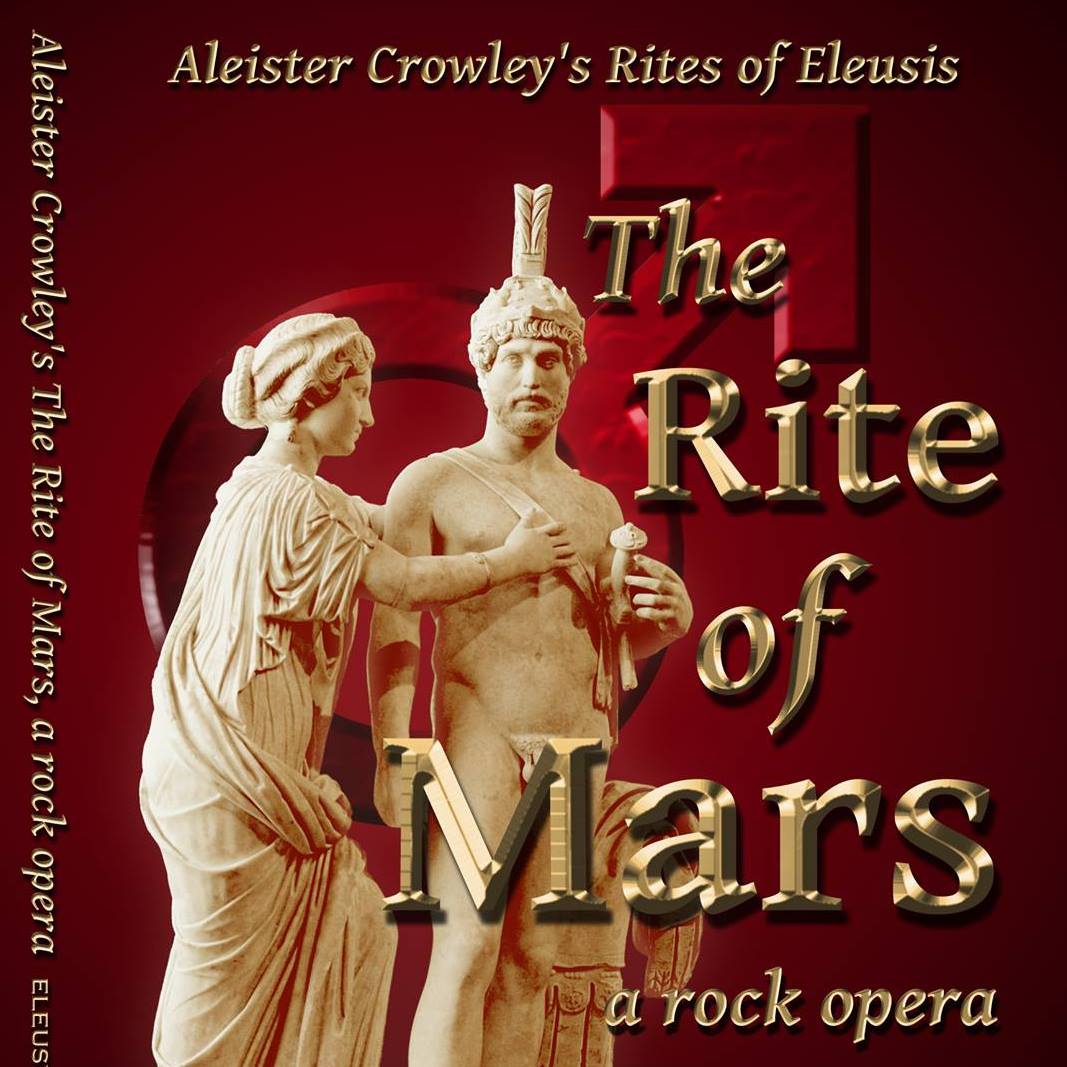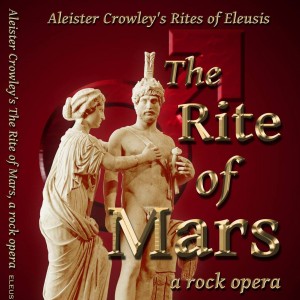On March 13, 2015, Eleusyve Productions released a DVD and on-demand video of its rock opera adaptation of Aleister Crowley’s The Rite of Mars, filmed in Seattle, Washington, during its September 2014 performances.
The Rite of Mars is part of the Rites of Eleusis ritual cycle written by Aleister Crowley in 1910 and performed for the public by members of the A.’.A.’. (including Crowley, violinist Leila Waddell, and poet Victor Neuburg). The rites were performed at London’s Caxton Hall on seven consecutive Wednesdays from October 19 – November 30, 1910, with each play portraying in dramatic and poetic form the archetypal forces associated with one of the seven planets of traditional astrology. In its day it was mystifying to some and scandalous to others, but today historians of theater recognize The Rites of Eleusis as a groundbreaking and innovative mix of music, dance, poetry, and sacred drama (for example, see here and here).
Just as Shakespeare’s works have been adapted to various different settings–from World War II or the Falklands War to Joss Whedon’s house–so too has The Rites of Eleusis by Warwickshire’s other native son been creatively staged by subsequent generations of magicians and actors.
Eleusyve Productions’ Rite of Mars is part of an ongoing project to adapt all seven parts of Crowley’s opus into a rock opera format. To date, they have tackled Mars (2014), Sol (2012), Mercury (2010), Venus (2007), and Luna (2005). Jupiter—for which principal composer Jon Sewell originally wrote music back in 2001—will be the next performance for Eleusyve Productions, some time around 2016.
The Rite of Mars opens in the military camp of Mars, where his soldiers are gathering for battle. The armies of Aries and Scorpio (zodiacal signs ruled by Mars) are already present, and upon the arrival of the forces of Capricorn (in which Mars is exalted) they are challenged by the other soldiers until one and all are welcomed by Mars. The individuals prepare themselves in different ways for the upcoming combat before finally marching off into battle. The second act opens with the returning troops tending to their wounded and mourning those they have lost. Grief sets into motion a series of events which unfold into the story’s finale.
Since this production deals with battle and its aftermath, director Melissa Holm made an effort to portray these subjects respectfully and realistically, as much as one can in musical theater. Her research involved interviewing veterans about their service, and ongoing input from cast members with current or past military experience ensured that artistic decisions conveyed a level of authenticity. Thus, all characters in the first act display distinct and appealing personalities so that the losses in the second act are felt by the audience.
The inventive costuming, staging, and set-pieces in The Rite of Mars are all informed by planetary and zodiacal correspondences associated with that planet. This includes a broad range of influences and inspirations. For instance, part of the choreography is inspired by the Maori Haka (war dance), while the temple “veil” is represented by movable panels of chain link fence (which are put to very good use in staging). The attention to detail is reflected in even small touches like the Mars-themed dog tags worn by the troops.
All in all, Eleusyve Productions pulled off an ambitious undertaking for an independent theater company. Their productions just get better with every rite they tackle, and editor Bob Jones has done a terrific job of putting together footage from their multi-camera shoots into a package that captures the energy of being in the audience for these performances. Jones’s edit is rounded out by the incorporation of archival military footage. The result is a package where all the elements—videography, choreography, set design, music, and acting—all support the over-arching goal of dramatically portraying Aleister Crowley’s expression of an ancient planetary archetype.
Since this adaptation is a musical work, the subject of music deserves particular attention because to call this a “rock opera” is almost an injustice to the amount of thought that goes into one of these productions. Being a magician as well as a musician, composer Jon Sewell scores each rite based upon symbolic correspondences of the planet sacred to that rite. To accomplish this, he begins with the assignment of musical notes to the Hebrew alphabet, planets, signs of the zodiac, and Tarot cards given in Paul Foster Case’s The Tarot: A Key to the Wisdom of the Ages (which in turn may have been drawn from Allan Bennett’s Golden Dawn diaries).
For example, Mars is attributed to C; and the astrological signs ruled by Mars are attributed to C (Aries) and G (Scorpio). C and G form a perfect fifth, the archetypal rock-and-roll chord form (according to Pete Townsend) because that pesky third doesn’t get in the way. Following these musical correspondences, major sections of The Rite of Mars are written in the key of C minor or C harmonic minor, including the “Overture,” “91st Psalm,” “Artemisia March,” “Via Vitae,” and “Orpheus to Venus.” Furthermore, in sections which foreshadow a shift toward the Sun—and in the “Invocation of Sol” itself—the music is in the solar key of D major, avoiding notes that this key has in common with C.
When dealing with sacred names—as in a group performance of the Lesser Banishing Ritual of the Pentagram—the melody is dictated by the notes corresponding to those names. Thus, Adonai (אדני, ADNI or “Lord”) is sung to a melody using the notes E, F#, G, and F, while the name of the Archangel Gabriel (בריאל, GBRIAL) is sung using the notes G#, E, D, F, E, F#.
Finally, the planetary or zodiacal nature of the character singing a given part may also dictate the tempo and feel of the corresponding music. Thus in The Rite of Mars we are not surprised to hear a march, or the use of militaristic snare rolls. And because the planetary number of Mars is five, we find that “The Dominion of Azrael” is in 5/4, while the “Overture” and “Artemesia March” include measures in 5/4.
These details may not be obvious to the casual viewer, but are an inseparable part of the magical intention subtly woven into this ritualized theater (or is it theatrical ritual?). It reflects the amount of meditation and thought put into every facet of the work. As a result, the symbolism incorporated into the production adds rich, deep layers of magick to the already powerful Rite of Mars.



